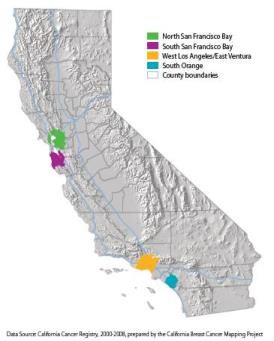Improving Breast Cancer Patient Outreach and Education

Submission Date: March 2015
State/Territory Submitted on the Behalf of: California
States/Territories Involved: California
Funding Source: CDC
CDC Funding:Yes
Domain Addressed:Epidemiology and Surveillance
Public Health Issue:Lack of Data Limits Delivery of Breast Cancer Services and Education
Breast cancer is the most common cancer among women in California. Breast cancer data are usually analyzed and reported for the state as a whole or at the county level. Not having city or neighborhood level data makes it difficult for public health professionals and health care providers to identify specific areas that are most in need of breast cancer services.
The California Tracking Program recruited and worked with an advisory group of breast cancer advocates, clinicians, and public health agencies to determine the best way to map breast cancer data for the state. The advisory group decided that the maps should show data not limited by county boundaries.
The tracking program then analyzed and mapped invasive breast cancer data showing geographic areas with elevated rates, including portions of East Ventura and West Los Angeles. This was surprising because Ventura and Los Angeles Counties had not shown consistently elevated rates of invasive breast cancer when shown in previous county-level maps.
The tracking program enhanced the cancer data by providing and analyzing demographic data for the areas with elevated rates, which was a key recommendation from the advisory group. Doing so highlighted that, compared to breast cancer patients across California, the women who were diagnosed with invasive breast cancer in the East Ventura/West Los Angeles area were more likely to be uninsured or receiving government assistance at the time of diagnosis.
Impact/Accomplishments:A Los Robles Hospital & Medical Center oncology nurse saw the tracking program’s maps and wanted to learn more about the findings. The hospital, located in East Ventura invited the tracking program to present the findings to the breast cancer leadership committee and health care providers. Following this presentation and subsequent meetings, the breast cancer leadership committee used the mapping results to focus some of their outreach and education on low-income clients. They incorporated breast cancer–specific messages into other hospital education and outreach efforts. The tracking program’s maps helped them identify and focus efforts on meeting the needs of women in their community.
“The California Tracking Program’s Breast Cancer Mapping Project was instrumental in raising our awareness about the elevated breast cancer rates in the area our hospital serves. By providing data that was previously unavailable, the study helped us create educational and administrative strategies to improve screening of our population in order to detect cancer as early as possible. We hope this will lead to improved health among the women we serve.” –Cathy J. F. Cole, NP-BC, MPH, CHES, CBPN-IC, Oncology Nurse Navigator Breast Program, Los Robles Hospital and Medical Center, Thousand Oaks, CA
http://cehtp.org
Cancer
State Contact Information:
CA
California Public Health Tracking Program
